Rajasthan Board RBSE Class 12 Chemistry Chapter 11 Organic Compounds with Functional Group-Containing Oxygen (Part-1)
RBSE Class 12 Chemistry Chapter 11 Text Book Questions
RBSE Class 12 Chemistry Chapter 11 Multiple Choice Questions
Question 1.
Which of the following is not obtained in any condition by the reaction of ethanol and conc.H2SO4?
(a) CH3CHO
(b) CH3CH2HSO4
(c) C2H4
(d) CH3CH2OCH2CH3
Question 2.
General formula of alcohol is
(a) CnH2n+2O
(b) CnH2n+1O
(c) Cn+1H2nO
(d) Cn+2HnO
Question 3.
R-MgX + HCHO \(\xrightarrow [ Ether ]{ Dry } \) [P], here [P] is

Question 4.
The final product obtained by the reaction between alcohol and phosphorus pentachloride is
(a) Chloro alkene
(b) Dichloro alkene
(c) Chloroalkane
(d) Dichloro alkane
Question 5.
Which of the following phenol is strongest?
(a) o – nitrophenol
(b) m – nitrophenol
(c) p – nitrophenol
(d) p – chlorophenol
Question 6.
Victor Mayer test is not given by
(a) C2H5OH
(b) (CH3)3COH
(c) (CH3)2CHOH
(d) CH3CH2CH2OH
Question 7.
Which one of the following is the strongest acid?
(a) Phenol
(b) m – chlorophenol
(c) Benzyl alcohol
(d) Cyclohexanol
Question 8.
The product formed when salicylic acidic heated with soda lime is
(a) Methyl Alcohol
(b) Ether
(c) Ethyl Alcohol
(d) phenol
Question 9
Phenol + Chloroform + Base → Main product. Main product is
(a) Salicylaldehyde
(b) Formaldehyde
(c) ketone
(d) Acetaldehyde
Question 10.
The product formed when ether is passed on alumina at 653 K is
(a) Alkene
(b) Alkane
(c) Alcohol
(d) Phenol
Answers:
1. (a)
2. (b)
3. (a)
4. (c)
5. (c)
6. (b)
7. (b)
8. (d)
9. (a)
10. (a)
RBSE Class 12 Chemistry Chapter 11 Very Short Answer Type Questions
Question 1.
Write the general formula of alcohol.
Answer:
CnH2n+1 OH or R – OH.
Question 2.
Write the IUPAC name of ethyl alcohol.
Answer:
Ethanol.
Question 3.
Write the name of the product formed when Grignard’s reagent reacts with formaldehyde.
Answer:
When Grignard’s reagent reacts with formaldehyde primary alcohol forms.
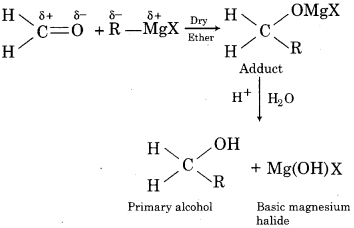
Question 4.
Write the order of acidity for primary, secondary and tertiary alcohols.
Answer:
Primary (1°) > Secondary (2°) > Tertiary (3°).
Question 5.
Write Fries rearrangement.
Answer:
Fries Rearrangement:
When phenol is treated with acetyl chloride, phenyl esters are formed. When phenyl ester is heated in nitrobenzene in the presence of anhydrous AlCl3 it undergoes rearrangement in which acyl group \(\overset { { – }C{ -{ R } } }{ \underset { O }{ \parallel } } \) migrates from the phenolic oxygen to an ortho and para position. This reaction is called Fries Rearrangement.
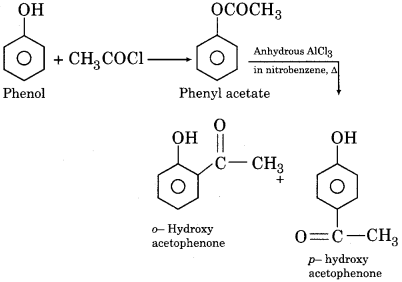
Question 6.
What happens when phenol is kept open in the air?
Answer:
Phenol gets slowly oxidised to a pink coloured compound p – benzoquinone when exposed to air.
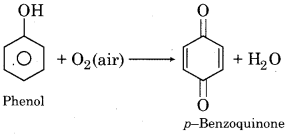
Question 7.
What is the effect of electron withdrawing groups on the acidity of phenol?
Answer:
When an electron withdrawing group like the nitro group is present on the benzene ring, the acidic strength of phenol increases. When these groups are present at ortho and para positions then their effect is more because delocalisation of negative charge is more effective in peroxide ion.
Question 8.
Write the general formula of ether.
Answer:
R – O – R’ where R = R’ in simple ethers while R ≠ R’ in mixed ethers.
RBSE Class 12 Chemistry Chapter 11 Short Answer Type Questions
Question 1.
Explain Hydroboration-Oxidation reaction.
Answer:
Hydroboration-Oxidation Reaction:
Indirect hydration of alkenes can also be done by hydroboration-oxidation which is completed in two steps. In the first step, alkenes react with diborane (B2H6) as boron hydride (BH3) to form an alkyl borane. In fact, the boron atom along with the hydrogen atom gets attached to the double bonded carbon atom with more number of hydrogen atoms. One hydrogen atom is then transferred to the other carbon atom. In this manner, all the three hydrogen atoms of boron are transferred to alkene molecule to form trialkyl borane as the product. In the next step, the alkyl borane is oxidized by alkaline H2O2 to form an alcohol. The indirect hydration process according to Antimarkownikov’s rule.
For example:

Question 2.
Write a method for preparation of primary alcohol from Grignard’s reagent.
Answer:
(i) The Grignard reagent reacts with formaldehyde to form primary alcohol.
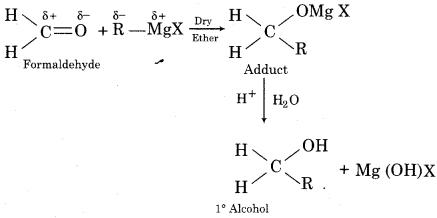
(ii) When Grignard reagent reacts with oxirane an adduct forms which on hydrolysis gives primary alcohol.
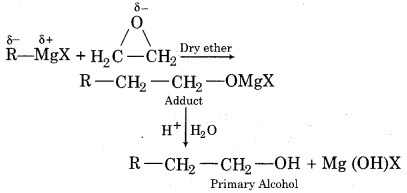
Question 3.
Alcohols are soluble in water whereas diethyl ether is not, explain with reason.
Answer:
The solubility of alcohol in water is due to excessive intermolecular hydrogen bonding in their molecules.

The extent of hydrogen bonding in diethyl ether is less as compared to alcohols. Therefore diethyl ether is soluble in water only to a small extent.
Question 4.
Explain two commercial methods for the preparation of phenol.
Answer:
(i) From Cumene:
Phenol is prepared commercially from cumene. Cumene is isopropyl benzene formed by the alkylation of benzene with propane in the presence of H3PO4 (Friedel Craft reaction) at 523 K).
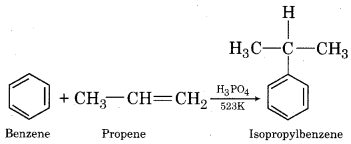
Oxygen is bubbled through the above solution to form cumene hydroperoxide which is decomposed with aqueous acid to form phenol and acetone as follows:

(ii) From Coaltar:
Phenol can also be prepared from the middle oil fraction (440 to 503 K) of coal tar distillation which mainly consists of phenol and naphthalene. Upon cooling the fraction, crystals of naphthalene separate out. The remaining oily solution is washed with dilute H2S04 to dissolve the basic impurities. From the solution, left phenol is extracted with aqueous NaOH to form soluble sodium phenate. CO2 is then blown through the solution to liberating phenol.
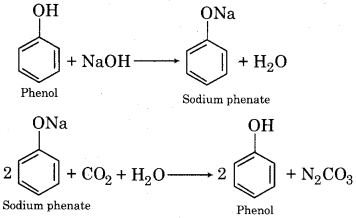
Question 5.
Phenols show less acidity in comparison to carboxylic acids. Explain with reason.
Answer:
Carboxylic acids are stronger acids than phenols. It can be understood by comparing the hybrid structures of carboxylate ion and phenoxide ion. In carboxylate ion, the negative charge is equally distributed over two negatively charged oxygen atoms while in phenoxide ion it is present only on one oxygen atom. Thus carboxylate ion is more stabilised as compared to phenoxide ion. Hence carboxylic acids ionize to the greater extent than phenols furnishing higher concentration of H+ ions. Therefore carboxylic acids behave as stronger acids than phenols.
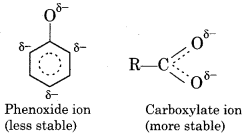
Question 6.
Write the following reactions:
1. Gattermann Reaction.
2. Reimer-Tiemann reaction
3. Duff reaction
Answer:
1. Gattermann reaction:
When phenol reacts with the mixture of HCN and HCl in the presence of catalyst ZnCl2, aldimine formed as intermediate, on hydrolysis aldimine forms p-hydroxybenzaldehyde.
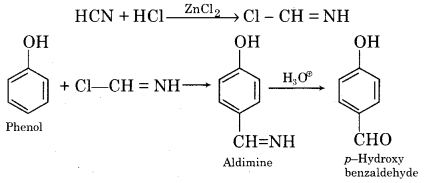
This reaction is called Gattermann reaction.
2. Reimer-Tiemann Reaction:
When phenol reacts with chloroform in the presence of bases (NaOH/KOH), an aldehyde (-CHO) group gets introduced in the ring at a position ortho to the phenolic group and salicylaldehyde is formed.

This reaction is called the Reimer-Tiemann reaction.
3. Duff Reaction:
When phenol is heated with hexamethylene tetramine[(CH2)6N4] and boric acid (H3BO3) in the presence of glycerol salicylaldehyde is formed. This reaction is called the Duff reaction.
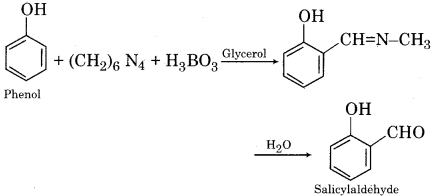
Question 7.
Explain the halogenation reactions of diethyl ether.
Answer:
Halogenation reactions of diethyl ether:
When diethyl ether is heated with chlorine or bromine then hydrogen atoms present on a-carbon of ether get substituted by a halogen atom.
(i) Halogenation in dark:
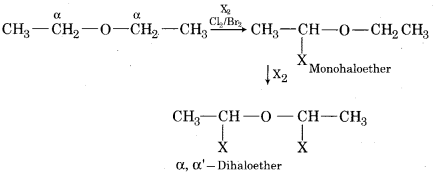
(ii) Halogenation in the presence of sunlight:
Diethyl ether reacts with chlorine in the presence of sunlight to form a per-chloro-diethyl ether.

RBSE Class 12 Chemistry Chapter 11 Long Answer Type Questions
Question 1.
What does alcohol form by reaction with the following:
1. PCl3
2. SOCl2
Answer:
1. Reaction with PCl3:
Alcohols react with PCl3 to form alkyl halides.
![]()
For example:

2. Reaction with SOCl2:
Alcohols react with thionyl chloride in the presence of pyridine to form alkyl chlorides.
![]()
For example:
![]()
Question 2.
What does phenol form by reaction with the following:
1. HCN and HCl
2. In the presence of NaOH or KOH
Answer:
1. When phenol reacts with the mixture of HCN and HCl in the presence of ZnCl2 catalyst aldimine formed as intermediate. On hydrolysis, aldimine forms p-hydroxybenzaldehyde. This reaction is known as Gattermann reaction.
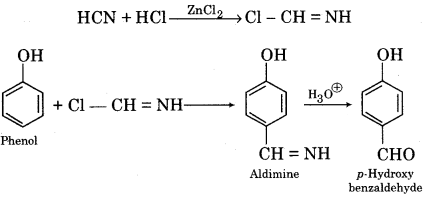
2. When phenol reacts with chloroform in the presence of bases (NaOH/ KOH) an aldehyde group (-CHO) gets introduced in the ring at a position ortho to the phenol group and salicylaldehyde is formed. This reaction is called the Reimer-Tiemann reaction.

Question 3.
Write the substitution reactions of diethyl ether.
Answer:
Substitution reactions of diethyl ether. When diethyl ether is heated with chlorine or bromine then hydrogen atoms present or a – carbon of diethyl ether gets substituted by halogen atoms.
(i) Halogenation in dark:
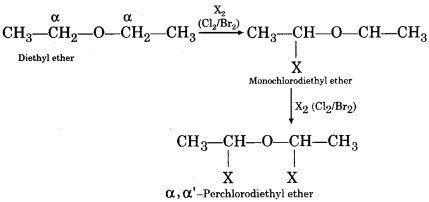
(ii) Halogenation in presence of sunlight:
Diethyl ether reacts with chlorine in the presence of sunlight to form a per-chloro-diethyl ether.
